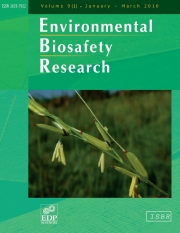Article contents
Outcrossed cottonseed and adventitious Btplantsin Arizona refuges
Published online by Cambridge University Press: 16 April 2008
Abstract
Outcrossing of non-Bt cotton (Gossypium hirsutum (L.)) in refuges by transgenic Bt cultivars could reduce the efficacy of refuges for delaying resistance in seed-feeding pests. Based on reports that outcrossing decreased as distance from Bt cotton increased in small-scale studies, we hypothesized that increasing refuge width or distance from Bt fields would reduce outcrossing. In a large-scale study in Arizona, we quantified Bt seed in refuges of experimental and commercial fields, comparing outcrossing between in-field (narrow) and external (wide) refuges and among rows of refuges at various distances from Bt fields. Some refuges, including those in tightly controlled experimental plots, contained up to 8% adventitious Bt plants. Some, but not all, Bt plants likely resulted from Bt seed in the non-Bt seed bags. We did not detect a difference in outcrossing between in-field and external refuges. However, statistical power was low because outcrossing was low (< 0.4% of seeds) in both treatments. Higher outcrossing levels (≤ 4.6% of seeds) were observed in the studies measuring outcrossing at various distances from Bt fields, yet outcrossing did not decrease as the distance from Bt fields increased. We hypothesize that Bt plants in refuges cross-pollinated surrounding non-Bt plants, overshadowing the expected association between distance from Bt fields and outcrossing.
- Type
- Research Article
- Information
- Copyright
- © ISBR, EDP Sciences, 2008
References
- 15
- Cited by


